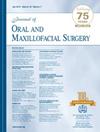Oral and Maxillofacial Surgery Complication Rates at a Major Teaching Hospital: A 9-Year Retrospective Review
IF 2.3
3区 医学
Q2 DENTISTRY, ORAL SURGERY & MEDICINE
引用次数: 0
Abstract
Background
Postoperative complications in oral and maxillofacial surgery (OMS) can prolong recovery, increase health care costs, and negatively impact patient outcomes. Identifying complication trends is crucial for improving patient care and safety, particularly in academic settings where balancing surgical training and patient safety is essential.
Purpose
The study purpose is to measure and identify trends in the prevalence of OMS complications over a 9-year period at a major teaching hospital.
Study Design, Setting, Sample
This retrospective cohort study was conducted at Memorial Hermann Hospital, Texas Medical Center, Houston. The study included 4,466 documented operations performed between July 1, 2014, and June 30, 2023, with no exclusions.
Predictor Variable
The primary predictor variable was date of surgery, measured in years. A secondary predictor variable was procedure type, categorized into 8 groups: trauma, infection, dentoalveolar, reconstruction, pathology, critical care, orthognathic, and temporomandibular joint disorder.
Main Outcome Variable
The primary outcome variable was the occurrence of postoperative complications, defined as any adverse outcome or unintended consequence resulting from medical or surgical treatment and documented as a morbidity or mortality event. A secondary outcome variable was complication type.
Covariates
Age and sex associated with procedures were collected.
Analyses
Demographic variables were computed at the subject level. Descriptive analysis at the procedure level was used to calculate the prevalence of complications. A generalized linear model assessed trends in complication prevalence, procedure volume, and complication type over time, while Fisher’s exact test examined the relationship between procedure type and complication type. A P value of <.05 was considered statistically significant.
Results
The sample was composed of 4,466 operations and 4,453 subjects with a mean age of 41.4 (±4.6) and 2,724 (61%) were male. There were 325 (7.28%) complications. There was no statistically significant trend in the prevalence of complications over time (B-coefficient 0.002, 95% CI −3.9 to 0.004, P = .1). There was a significant association between procedure type and complication type (P < .001). Orthognathic procedures exhibited the highest proportion of complications at 17.4% (n = 4), while critical care procedures demonstrated the lowest at 2.0% (n = 4).
Conclusion and Relevance
No statistically significant trend in the prevalence of complications was observed, but procedure type was associated with complication type.
某大型教学医院口腔颌面外科并发症发生率:9年回顾性分析。
背景:口腔颌面外科术后并发症可延长康复时间,增加医疗保健费用,并对患者预后产生负面影响。确定并发症趋势对于改善患者护理和安全至关重要,特别是在平衡手术培训和患者安全至关重要的学术环境中。目的:研究目的是测量和确定一家大型教学医院9年期间并发症的流行趋势。研究设计、环境、样本:本回顾性队列研究在休斯顿德州医学中心纪念赫尔曼医院进行。该研究包括2014年7月1日至2023年6月30日期间进行的4466例有记录的手术,没有排除。预测变量:主要预测变量为手术日期,以年为单位。次要预测变量是手术类型,分为8组:创伤、感染、牙槽牙、重建、病理、重症监护、正颌和颞下颌关节紊乱。主要结局变量:主要结局变量是术后并发症的发生,定义为任何不良结果或因医疗或手术治疗而导致的意外后果,并记录为发病率或死亡率事件。次要结局变量为并发症类型。协变量:收集与手术相关的年龄和性别。分析:在受试者水平上计算人口统计学变量。采用手术水平的描述性分析来计算并发症的发生率。广义线性模型评估了并发症患病率、手术量和并发症类型随时间的变化趋势,而Fisher的精确检验检验了手术类型和并发症类型之间的关系。结果P值:共4466例手术,4453例患者,平均年龄41.4(±4.6)岁,男性2724例(61%)。并发症325例(7.28%)。并发症发生率随时间变化无统计学意义(b系数0.002,95% CI -3.9 ~ 0.004, P = 0.1)。手术方式与并发症类型有显著相关性(P)结论及相关性:并发症发生率无统计学意义,但手术方式与并发症类型相关。
本文章由计算机程序翻译,如有差异,请以英文原文为准。
求助全文
约1分钟内获得全文
求助全文
来源期刊

Journal of Oral and Maxillofacial Surgery
医学-牙科与口腔外科
CiteScore
4.00
自引率
5.30%
发文量
0
审稿时长
41 days
期刊介绍:
This monthly journal offers comprehensive coverage of new techniques, important developments and innovative ideas in oral and maxillofacial surgery. Practice-applicable articles help develop the methods used to handle dentoalveolar surgery, facial injuries and deformities, TMJ disorders, oral cancer, jaw reconstruction, anesthesia and analgesia. The journal also includes specifics on new instruments and diagnostic equipment and modern therapeutic drugs and devices. Journal of Oral and Maxillofacial Surgery is recommended for first or priority subscription by the Dental Section of the Medical Library Association.
 求助内容:
求助内容: 应助结果提醒方式:
应助结果提醒方式:


